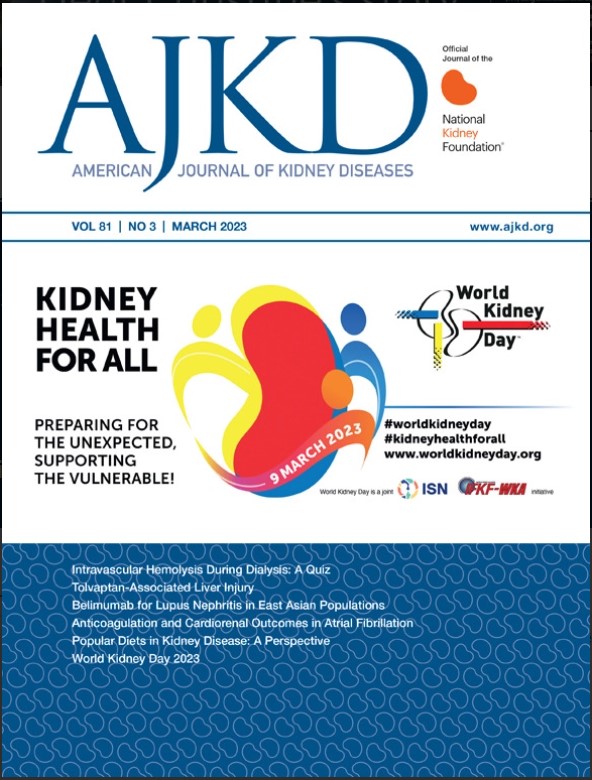Longitudinal Income Dynamics and Risk of End-Stage Kidney Disease in Type 2 Diabetes: A South Korean Population-Based Cohort Study.
IF 9.4
1区 医学
Q1 UROLOGY & NEPHROLOGY
引用次数: 0
Abstract
RATIONALE & OBJECTIVE The prevalence of end-stage kidney disease (ESKD) continues to rise, with socioeconomic status (SES), particularly income, having associations with ESKD risk among individuals with type 2 diabetes (T2D). This study examined the longitudinal association of income changes with ESKD risk among non-elderly adults with T2D in South Korea. STUDY DESIGN Population-based retrospective cohort study. SETTING & PARTICIPANTS 1,481,371 adults aged 30 to 64 years with T2D represented in the South Korean National Health Insurance Service (NHIS) database in 2015 and 2016, followed to 2020. EXPOSURE Sustained income levels, income variability, and income changes over five years prior to entry into the study cohort. OUTCOMES Primary outcome was progression to ESKD, defined as initiation of dialysis or kidney transplantation. ANALYTICAL APPROACH Cox proportional hazards models were used to assess the risk of ESKD, adjusting for demographic, behavioral, and clinical variables. RESULTS Compared with those who never reached the lowest income quartile, individuals who spent any time (1-5 years) in the lowest quartile had a higher risk of ESKD (P for trend < 0.001). Conversely, spending 2-5 years in the highest quartile was significantly associated with a lower ESKD risk (P for trend < 0.001), whereas spending only 1 year in the highest quartile was not associated with ESKD risk. Income that dropped from a higher quartile to the lowest quartile was associated with higher risk, and even those moving from the lowest to the highest quartile had a higher ESKD risk than those who remained consistently in the highest quartile. Individuals with the highest income variability exhibited an increased risk of ESKD (hazard ratio 1.14, 95% confidence interval 1.01-1.29, P for trend = 0.02). LIMITATIONS Residual confounding, lack of data on medication adherence, and missing laboratory results. CONCLUSIONS Dynamic changes in income were associated with ESKD risk among adults with T2D, findings that may inform healthcare policies that address the economic factors potentially contributing to kidney disease progression in South Korean adults with diabetes.2型糖尿病终末期肾脏疾病的纵向收入动态和风险:一项基于韩国人群的队列研究
理由与目的在2型糖尿病(T2D)患者中,终末期肾病(ESKD)的患病率持续上升,社会经济地位(SES),特别是收入与ESKD风险相关。本研究调查了韩国非老年T2D患者中收入变化与ESKD风险的纵向关联。研究设计:基于人群的回顾性队列研究。背景和参与者:2015年和2016年,韩国国民健康保险服务(NHIS)数据库中有1481371名年龄在30至64岁之间的T2D患者,随访至2020年。研究对象入组前5年的持续收入水平、收入可变性和收入变化。主要结局是进展为ESKD,定义为开始透析或肾移植。分析方法cox比例风险模型用于评估ESKD的风险,调整了人口统计学、行为和临床变量。结果与从未达到最低收入四分位数的人相比,在最低收入四分位数中度过任何时间(1-5年)的人患ESKD的风险更高(P < 0.001)。相反,在最高四分位数中度过2-5年与ESKD风险降低显著相关(趋势P < 0.001),而在最高四分位数中度过1年与ESKD风险无关。收入从较高的四分位数下降到最低的四分位数与更高的风险相关,甚至那些从最低的四分位数上升到最高的四分位数的人也比那些一直保持在最高四分位数的人有更高的ESKD风险。收入变异性最高的个体患ESKD的风险增加(风险比1.14,95%可信区间1.01-1.29,P为趋势值= 0.02)。局限性:残留混淆,缺乏药物依从性数据,缺少实验室结果。结论:收入的动态变化与成年T2D患者的ESKD风险相关,研究结果可能为医疗保健政策提供信息,以解决可能导致韩国成年糖尿病患者肾脏疾病进展的经济因素。
本文章由计算机程序翻译,如有差异,请以英文原文为准。
求助全文
约1分钟内获得全文
求助全文
来源期刊

American Journal of Kidney Diseases
医学-泌尿学与肾脏学
CiteScore
20.40
自引率
2.30%
发文量
732
审稿时长
3-8 weeks
期刊介绍:
The American Journal of Kidney Diseases (AJKD), the National Kidney Foundation's official journal, is globally recognized for its leadership in clinical nephrology content. Monthly, AJKD publishes original investigations on kidney diseases, hypertension, dialysis therapies, and kidney transplantation. Rigorous peer-review, statistical scrutiny, and a structured format characterize the publication process. Each issue includes case reports unveiling new diseases and potential therapeutic strategies.
 求助内容:
求助内容: 应助结果提醒方式:
应助结果提醒方式:


